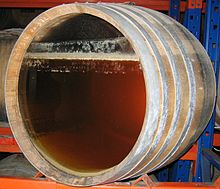
Ullage (from the French ouillage) is a winemaking term that has several meanings but most commonly refers to the headspace of air between wine and the top of the container holding the wine. It can also refer to the process of evaporation that creates the headspace itself or it can be used as a past tense verb to describe a wine barrel or bottle that has gone through the evaporation process (to be ullaged, etc.). The headspace of air is a mixture mostly of alcohol and water vapors with carbon dioxide that is a by-product of the fermentation process. In containers that are not completely air-tight (such as an oak wine barrel or a cork-stoppered wine bottle), oxygen can also seep into this space. While some oxygen is beneficial to the aging process of wine, excessive amounts can lead to oxidation and other various wine faults. This is why wine in the barrels is regularly "topped up" and refilled to the top with wine in order to minimize the head space. In the bottle, the ullage or "fill level" of the wine can be an important indicator of the kind of care and storage conditions that the wine was kept in. After-market resellers and wine auction houses will often inspect the ullage levels of older vintages to determine the potential quality and value of wine.[1]
- ^ J. Robinson (ed). "The Oxford Companion to Wine" Third Edition, pp. 270, 702 & 718. Oxford University Press 2006 ISBN 0-19-860990-6.
